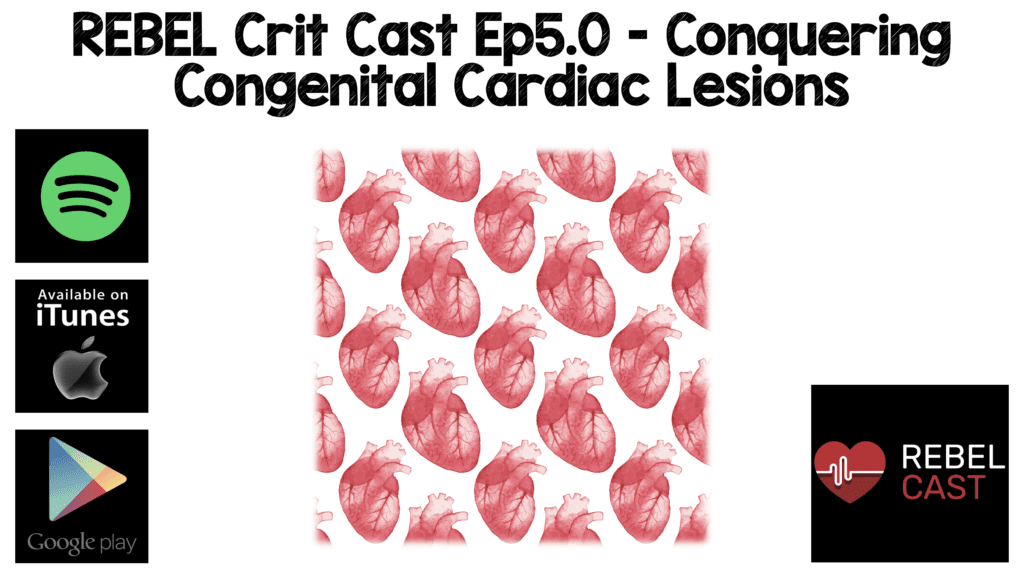
 There are generally 3 main congenital heart diseases presentations that young children between ages of 0 days to about 3 months will present with. Often times you will see experts split these congenital heart lesions into 2 categories: Cyanotic vs Acyanotic lesions. Either is an acceptable approach as long as you split the acyanotic lesions into 2 categories as their presentations vary widely as I will describe.
There are generally 3 main congenital heart diseases presentations that young children between ages of 0 days to about 3 months will present with. Often times you will see experts split these congenital heart lesions into 2 categories: Cyanotic vs Acyanotic lesions. Either is an acceptable approach as long as you split the acyanotic lesions into 2 categories as their presentations vary widely as I will describe.
REBEL Crit Cast Ep5.0 – Conquering Congenital Cardiac Lesions
Before we focus on the child with congenital heart lesions it’s important to have a systematic approach to the young newborn (0-28 days) and infant (1-12 months) as your history may be limited. My general approach to this age group but more specifically in children ~ 0-3 months of age is by a mnemonic: A SICC KID
- Abuse (Trauma) and CNS disasters
- Sepsis
- Inborn Errors of Metabolism
- Congenital Heart Disease
- Congenital Adrenal Hyperplasia
- Kalories (incorrectly made formula) : Hyponatremia, hypoglycemia and other electrolyte disorders
- Intestinal Disasters
- Drugs
Congenital Cardiac Lesions
- Cyanotic Heart Lesions: Right Heart Obstructive lesions
- Symptoms: Poor feeding, poor weight gain, lethargy, cyanosis (not responsive to supplemental oxygen)
- Age of presentation: Birth – 2 weeks (may have a late presentation ~ 3 weeks but usually most of these kids present days to no more than 2 weeks)
- Pathophysiology: Right sided lesions with restricted blood flow to the lung once the ductus arteriosus closes (The ductus arteriosus was supplying blood from the aorta to pulmonary artery)
- Lesions: Critical Pulmonary Stenosis, Tricuspid Atresia, Pulmonary Atresia, and Tetralogy of Fallot
- Treatment: Alprostadil (Prostaglandin E1) starting dose 0.05 mcg/kg/min, supplemental oxygen will not help and may help differentiate this from pulmonary disease.
Acyanotic Heart Lesions
The acyanotic group can be further divided into 2 groups and have very different presentations and pathophysiologies
2. The Left Heart Obstructive Lesions
- Symptoms: Poor feeding, poor weight gain, lethargy, shock
- Age of presentation: Birth – 2 weeks (may have a late presentation ~ 3 weeks but usually most of these kids present days to no more than 2 weeks)
- Pathophysiology: Left sided lesions with restricted blood flow to the systemic circulation once the ductus arteriosus closes (The ductus arteriosus was supplying blood from the pulmonary artery to the aorta)
- Lesions: Severe Aortic Stenosis, Interrupted Aortic Arch, Hypoplastic Left Heart Syndrome, and Coarctation of the Aorta
- Treatment: Alprostadil (Prostaglandin E1) starting dose 0.05 mcg/kg/min, supplemental oxygen, usually inotropic support (suggestion Epinephrine starting dose 0.05 mcg/kg/min)
3. Left to Right Shunts
These lesions have nothing to do with the closure of the ductus arteriosus and have to do with the normalization of right sided heart pressure. In utero, blood essentially bypasses the lungs and moves from the right atrium to the left atrium through the foramen ovale. At birth the right sided pressures are higher than left sided heart pressures but over the first 2-4 weeks of life the right sided pressures fall and the left sided pressure is higher.
- Symptoms: Poor feeding, poor weight gain, tachypnea, and heart failure symptoms (pulmonary edema)
- Age of presentation: 1 month to 3 months of age
- Pathophysiology: As right heart pressures fall, left sided heart pressures exceed right sided pressures and blood shunts from left to right through these lesions (ex. VSD). This increases pulmonary circulation and leads to pulmonary edema.
- Lesions: Ventricular Septal Defect, Large Atrial Septal Defect, Atrioventricular Canal Defect, and and Patent Ductus Arteriosus
- Treatment: Lasix 0.25mg/kg – 0.5mg/kg, Afterload reduction (ex. Captopril and extreme cases Milrinone), supplemental oxygen
Of note there is a 4th group of kids that present with cyanosis typically at birth that are termed Mixing Lesions that are ductal independent. There is mixing of pulmonary and systemic blood and these lesions do not respond to Alprostadil. If you see a cyanotic kid, you won’t be able to differentiate so typically Alprostadil is started and seek expert consultation.
Mixing Lesions: Truncus Arteriosus, Total Anomalous Pulmonary Venous Return, and Transposition of the Great Vessels
For More on This Topic Checkout:
- REBEL Cast: REBEL Core Cast Ep66.0 – Congenital Heart Issues
Post Peer Reviewed By: Salim R. Rezaie, MD (Twitter: @srrezaie)
The post REBEL Crit Cast Ep5.0 – Conquering Congenital Cardiac Lesions appeared first on REBEL EM - Emergency Medicine Blog.
